| Printing Process |
| Source: Published:2017-12-08 14:16:42 |
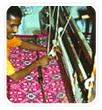 Applying coloured patterns and designs to decorate a finished fabric is called printing. In a proper printed fabric, the colour is affixed to the fiber, so that it may not be affected by washing and friction. Whether a fabric is dyed or printed can be known by examining the outline of the design. On a printed fabric, the outline of a design is sharply defined on the outer side. The design generally do not penetrate to the back of the cloth. However, the design may show up on the reverse side of transparently thin fabrics. These fabrics may be confused with the woven designs where yarn dyed warp and filling are used. If the design is printed on such a fabric, the yarns will show some areas on which colour is not equally distributed. Applying coloured patterns and designs to decorate a finished fabric is called printing. In a proper printed fabric, the colour is affixed to the fiber, so that it may not be affected by washing and friction. Whether a fabric is dyed or printed can be known by examining the outline of the design. On a printed fabric, the outline of a design is sharply defined on the outer side. The design generally do not penetrate to the back of the cloth. However, the design may show up on the reverse side of transparently thin fabrics. These fabrics may be confused with the woven designs where yarn dyed warp and filling are used. If the design is printed on such a fabric, the yarns will show some areas on which colour is not equally distributed. The Dyes used for printing mostly include vat, reactive, naphthol and disperse colours which have good fastness properties. The pigments, which are not truly dyes, are also used extensively for printing. These colours are fixed to the fiber through resins that are very resistant to laundering or drycleaning. Pigments are among the fastest known colours and are effective for light to medium shades. If used for applying dark colours, they may crock or rub off. Improved resins, better pigments or more effective anticrock agents must be used to solve this problem. Cheap prints are made from basic colours mixed with tartar emetic and tannic acid but they are not acceptable in todays market. For cotton printing vat and reactive dyes are generally used. Silk is usually printed with acid colours. Wool is printed with acid or chrome dyes but before printing it is treated with chlorine to make it more receptive to colours. Manmade fibers are generally printed with disperse and cationic dyes. Methods of Printing Three different approaches or techniques are prevalent for printing colour on a fabric: Direct, Discharge and Resist Direct Printing It is the most common approach to apply a colour pattern on fabric. It can be done on white or a coloured fabric. If done on coloured fabric, it is known as overprinting. The desired pattern is produced by imprinting dye on the fabric in a paste form. To prepare the print paste, a thickening agent is added to a limited amount of water and dye is dissolved in it. Earlier corn starch was preferred as a thickening agent for cotton printing. Nowadays gums or alginates derived from seaweed are preferred because they are easier to wash out, do not themselves absorb any colour and allow better penetration of colour. Most pigment printing is done without thickeners as the mixing up of resins, solvents and water itself produces thickening.  Discharge Printing Discharge PrintingIn this approach, the fabric is dyed in piece and then it is printed with a chemical that destroys the colour in the designed areas. Sometimes, the base colour is removed and another colour is printed in its place. The printed fabric is steamed and then thoroughly washed. This approach is on decline these days. Resist Printing In this technique, a resist paste is imprinted on the fabric and then it is dyed. The dye affects only those parts that are not covered by the resist paste. After dyeing, the resist paste is removed leaving a pattern on a dark background. There are various methods of printing in which one of the above three techniques is used - Block Printing, Roller Printing, Duplex Printing, Stencil Printing, Screen Printing, Transfer Printing, Blotch Printing, Jet Spray Printing, Electrostatic Printing, Photo Printing, Differential Printing, Warp Printing, Batik Dyeing, Tie Dyeing, Airbrush (Spray) Painting and Digital printing 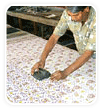 Block Printing Block PrintingThe designs are carved on a wooden or metal block and the paste dyestuff is applied to the design on the face of the block. The block is pressed down firmly by hand on the surface of the fabric. Roller Printing In this machine counterpart of block printing, engraved copper cylinders or rollers are used in place of handcarved blocks. With each revolution of the roller, a repeat of the design is printed. The printed cloth is passed into a drying and then a steam chamber where the moisture and heat sets the dye. Duplex Printing Printing is done on both sides of the fabric either through roller printing machine in two operations or a duplex printing machine in a single operation. Screen Printing 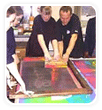 It is done either with flat or cylindrical screens made of silk threads, nylon, polyester, vinyon or metal. The printing paste or dye is poured on the screen and forced through its unblocked areas onto the fabric. Based on the type of the screen used, it is known as 'Flat Screen Printing' or 'Rotary Screen Printing'. It is done either with flat or cylindrical screens made of silk threads, nylon, polyester, vinyon or metal. The printing paste or dye is poured on the screen and forced through its unblocked areas onto the fabric. Based on the type of the screen used, it is known as 'Flat Screen Printing' or 'Rotary Screen Printing'. Stencil Printing The design is first cut in cardboard, wood or metal. The stencils may have fine delicate designs or large spaces through which colour is applied on the fabric. Its use is limited due to high costs involved. Transfer Printing The design on a paper is transferred to a fabric by vaporization. There are two main processes for this- Dry Heat Transfer Printing and Wet Heat Transfer Printing. In Conventional Heat Transfer Printing, an electrically heated cylinder is used that presses a fabric against a printed paper placed on a heat resistant blanket. In Infrared Heat Vacuum Transfer Printing, the transfer paper and fabric are passed between infrared heaters and a perforated cylinder which are protected from excessive heat by a shield. The Wet Heat Transfer Printing uses heat in a wet atmosphere for vaporizing the dye pattern from paper to fabric. Blotch Printing It is a direct printing technique where the background colour and the design are both printed onto a white fabric usually in a one operation. Any of the methods like block, roller or screen may be used. Airbrush (Spray) Painting 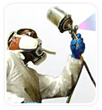 Designs may be hand painted on fabric or the dye may be applied with a mechanized airbrush which blows or sprays colour on the fabric Designs may be hand painted on fabric or the dye may be applied with a mechanized airbrush which blows or sprays colour on the fabricElectrostatic Printing A dye- resin mixture is spread on a screen bearing the design and the fabric is passed into an electrostatic field under the screen. The dye- resin mixture is pulled by the electrostatic field through the pattern area onto the fabric. Photo Printing The fabric is coated with a chemical that is sensitive to light and then any photograph may be printed on it. Differential Printing It is a technique of printing tufted material made of yarns having different dyeing properties such as carpets. Upto a ten colour effect is possible by careful selection of yarns, dyestuffs and pattern. Warp Printing 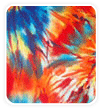 It is roller printing applied to warp yarns before they are woven into fabric. It is roller printing applied to warp yarns before they are woven into fabric. Tie Dyeing Firm knots are tied in the cloth before it is immersed in a dye. The outside of the immersed portion is dyed but the inside is not penetrated. There are various forms of Tie dyeing like Ikat Dyeing where bundles of warp and/ or weft yarns are tie dyed prior to their weaving. In Plangi Dyeing the gathered, folded or rolled fabric is usually held with stitching to form specific patterns. 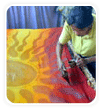 Batik Dyeing Batik DyeingIt is a resist dyeing process. Designs are made with wax on a fabric which is then immersed in a dye. The unwaxed portion absorbs the colour. Jet Spray Printing Designs are imparted to fabrics by spraying colours in a controlled manner through nozzles. Digital printing 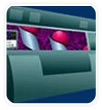 In this form of printing micro-sized droplets of dye are placed onto the fabric through an inkjet printhead. The print system software interprets the data supplied by a cademic_Textiledigital image file. The digital image file has the data to control the droplet output so that the image quality and color control may be achieved. This is the latest development in textile printing and is expanding very fast. Digital Textile Printing In this form of printing micro-sized droplets of dye are placed onto the fabric through an inkjet printhead. The print system software interprets the data supplied by a cademic_Textiledigital image file. The digital image file has the data to control the droplet output so that the image quality and color control may be achieved. This is the latest development in textile printing and is expanding very fast. Digital Textile Printing |